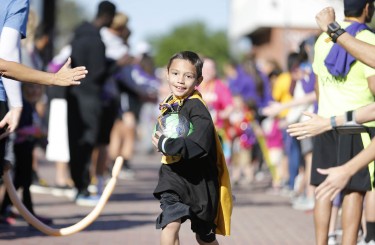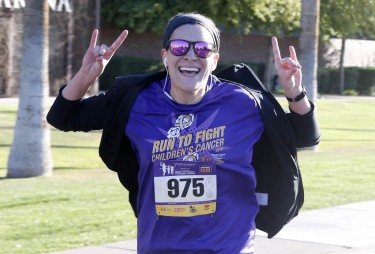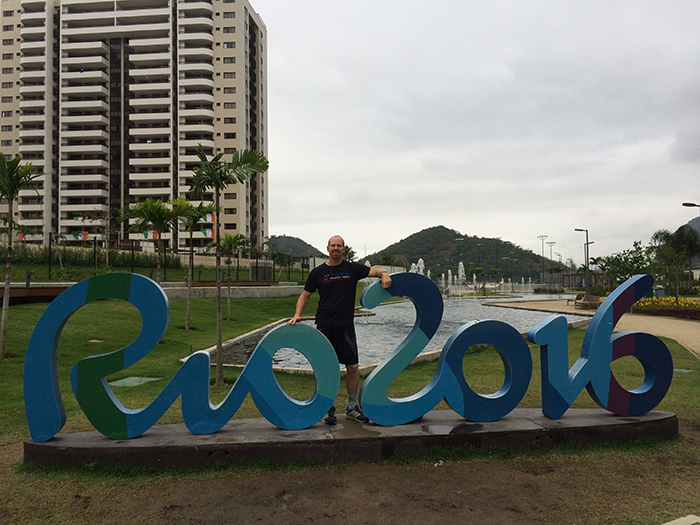
Article reposted from Grand Canyon University
Author:

Ryann Gentry, a junior student athletic trainer, tapes up the ankle of one of the GCU men’s basketball team players at the Sports Medicine Clinic.
By Lana Sweeten-Shults
GCU News Bureau
It’s 8:30 a.m., and Ryann Gentry, a junior athletic training major, is in the zone.
Armed with a roll of athletic tape, she’s focused, her eyes on the ankle of one of the Grand Canyon University men’s basketball team players as she circles the tape around and around. He’s just one in a line of players she’s taping – a first line of defense against ankle sprains, a common injury among basketball players. Director of Sports Medicine Geordie Hackett stands just a couple of taping tables down from her at the Sports Medicine Clinic and does the same, zipping through the task with steely focus and precision.
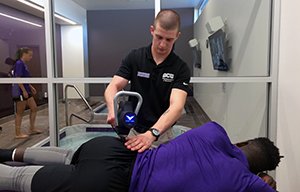
Sophomore student athletic trainer Justin Dickinson uses a RAPTOR soft percussion tool to relieve muscle soreness in one of the players.
“We’re getting the basketball team ready for practice. We’re getting them taped up and stretched, when needed,” said Gentry, who is working with the team as part of her clinical rotations at GCU.
Without the bright lights, band or cheerleaders that often go hand-in-hand with the athletes she treats, Gentry diligently works in the background, athletic tape in hand, making sure the machine of GCU athletics keeps barreling forward. She is just one of the many athletic training students serving other students at the University, not just by taping ankles but also by diagnosing and treating sprains, strains, abrasions, pulled muscles and the like and by aiding in the recovery process, from cold-water immersion therapy to massage therapy.
Not that those students are limited to treating other students. They also have assisted with such events as the GCU Wellness Challenge, taking employees’ measurements for the monthlong fitness challenge.
Across from Gentry, sophomore athletic training major Justin Dickinson is skirting the tape for more high-tech equipment.
“I’m pulling up your profile,” he tells one of the players as he stands at a tablet. It’s where he can look up that athlete’s past injuries, goals and current treatments using a program called Fusionetics.
“It keeps track of where they’re at, what they need to work on,” he said.
Then he readies the RAPTOR, a state-of-the-art, handheld percussion therapy device that looks a little like a police radar gun. He places the device on the gluteal muscle, where the player said he’s been feeling some soreness.
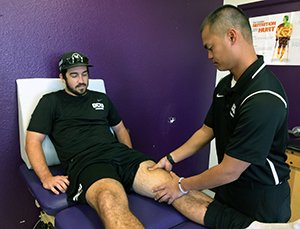
Jake Aganus, Head Club Sports Athletic Trainer, works on lacrosse player Josh Gruwell, who sprained his right ACL last year. Aganus said he and his student athletic trainers see about 120 club sports athletes a day at the Antelope Gym training room.
After the clinic, the athletic trainers pack up and head with the team to morning basketball practice. It’s where they launch rehabs for injured players who are sitting out practice and delve into preventive treatments, too – and they’re on site for immediate treatment in case an injury occurs.
New facility
The athletic training team operates a satellite clinic at the practice facility and occupies a corner of the gym, too, with some rehab equipment at the ready.
Michael McKenney, Clinical Coordinator of GCU’s Athletic Training Education Program, sees these student athletic trainers and the facilities they staff, peppered across campus, as an asset to the University community.
The GCU Athletic Training Program just moved into its new home on the first floor of Chaparral Hall in August.
“President (Brian) Mueller said, ‘Guys, we’re going to get you the space that you need.’” McKenney added, “We’re very excited about a dedicated space for our learners.”
The Athletic Training Program itself – one of the Sports Medicine specializations in the College of Nursing and Health Care Professions – has been around since 2002 and had humble beginnings. But the number of students has more than doubled since 2012.
The clinical rotations student athletic trainers complete meet three objectives, McKenney said: “It helps our students become critical thinkers. … I believe it helps them to become better communicators, and, thirdly, it allows our students to be servants of their peers.” Also, the athletic trainers get to apply what they’ve learned in class in a real-life setting.
While these student athletic trainers serve thousands of club and NCAA athletes, “We have future visions of partnering with intramural sports to provide student-to-student health care,” McKenney said. “… We want to partner with Student Life so students can come and receive a basic injury evaluation,” and then be given instructions for home care or advised to seek additional care at a different clinic, if need be.
The goal is not to interfere with GCU’s Canyon Health and Wellness Clinic, which provides basic health services to students, faculty and staff and is a training ground for the nursing college’s nurse practitioners.
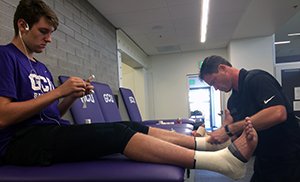
Director of Sports Medicine Geordie Hackett (right) said student athletic trainers get real-life training in their clinical rotations.
“We want to support her (clinic Director Connie Colbert),” McKenney said, adding that he sees student athletic trainers as relieving some of the high volume at the clinic.
Busy schedule
Student athletic trainers are required to complete 750 hours of clinical experience, which for many of them means 10 to 20 hours a week of working at a clinic.
One of the program’s preceptors, Jake Aganus, Head Athletic Trainer for GCU Club Sports, oversees some of those students’ work at the small club sports athletic training room on the track side of the Antelope Gym. Ask him how many athletes he and his student athletic trainers see a week, and he just smiles.
“Right now we’re averaging 82 a day. Those are actual injuries. That doesn’t include maintenance. If you include those, 120,” Aganus said.
GCU touts the largest club sports program in the nation. About 800 to 1,000 students participate in club sports, which are competitive sports not regulated by the NCAA or any other similar organization. The list of sports includes everything from rugby to lacrosse – 33 in all.
“It’s being focused on the student experience,” said Aganus, who last week took his students to watch a lacrosse game so they could observe the kind of repetitive throwing motions the athletes do. “… A lot of students that come to GCU played sports before and want to continue,” though not necessarily at the NCAA Division I level, he said.
That’s a lot of students being served by these student athletic trainers.
What’s different about going through a clinical rotation in club sports is that they see a variety of athletes with a variety of injuries, considering that the athletes in those 33 club sports use the Antelope Gym clinic.
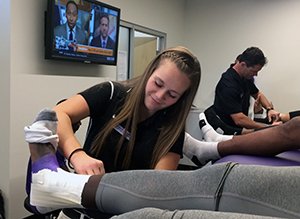
Junior student athletic trainer Ryann Gentry works about 10 to 20 hours a week to fulfill her clinical requirements for a degree in athletic training. Clinicals are a good way for her to serve her fellow GCU students. Director of Sports Medicine Geordie Hackett (right) teaches students in their clinicals.
Variety of needs
While Gentry and Dickinson are focusing on basketball in their rotation, student athletic trainers in club sports see just about everything.
Amanda Beers, a part-time graduate assistant, just received her bachelor’s degree in athletic training from GCU and is working on her master’s in business administration.
“Honestly, every day is different,” she said. “In the morning I might come in and there’s cheer practice. … With soccer, I have them come in every day, and I might see everything from an ankle injury to a concussion. It can be a knee, a shoulder, it can be anything.”
Aganus himself is working on lacrosse player Josh Gruwell’s rehabilitation. Gruwell sprained his right anterior cruciate ligament last year: “He’s been in rehab with me … until they won the (Men’s Collegiate Lacrosse Association Division I) national championship in May.”
Hackett said, “Students from our education program come out (to the Sports Medicine Clinic) and we provide an opportunity for them to practice what they’ve learned in a clinical environment. … Not only do they graduate with book smarts, but they also get their street smarts.”
Practicing real-life situations makes a difference, he said, and that learning on actual equipment rather than just reading about it assures that students are better prepared. He said GCU is one of just two universities in the state with an accredited athletic training program; the other is Northern Arizona University.
Students not only work on campus, serving their peers, they have the opportunity to complete rotations outside of GCU “in professional sports settings, doctors’ offices. … They get exposure to lots of different professionals.”
Gentry said, as a GCU student athletic trainer, she had the opportunity to work with the Milwaukee Brewers: “It was a cool experience. It was a good chance to network and get yourself out there.”
But, ultimately, she wants to work at the high school level. While college athletes are already on their way, she wants to help high school students in those early years get to the next level.
“I did a lot of sports in high school. I wanted to do something to keep me close to sports and I wanted something in medicine,” she said.
She likes being able to develop a relationship with the athletes she works with since she sees them for long periods of time, often through athletic seasons and rehabilitations – a kind of longevity that isn’t always there in traditional nursing. And she likes making a difference in an athlete’s life, particularly helping them achieve their goals.
Dickinson will be commissioned in the Army after graduation and wants to go into athletic training there.
He has worked with clients before and said, “My joy was helping people feel better, get better.” Even seeing someone “get up the stairs or do an activity (they couldn’t do before), that’s awesome.”
And for these student athletic trainers, being able to help their fellow students helps them do what they love – serve others.
Contact GCU senior writer Lana Sweeten-Shults at (602) 639-7901 or lana.sweeten-shults@gcu.edu. Follow her on Twitter @LanaSweetenShul.
